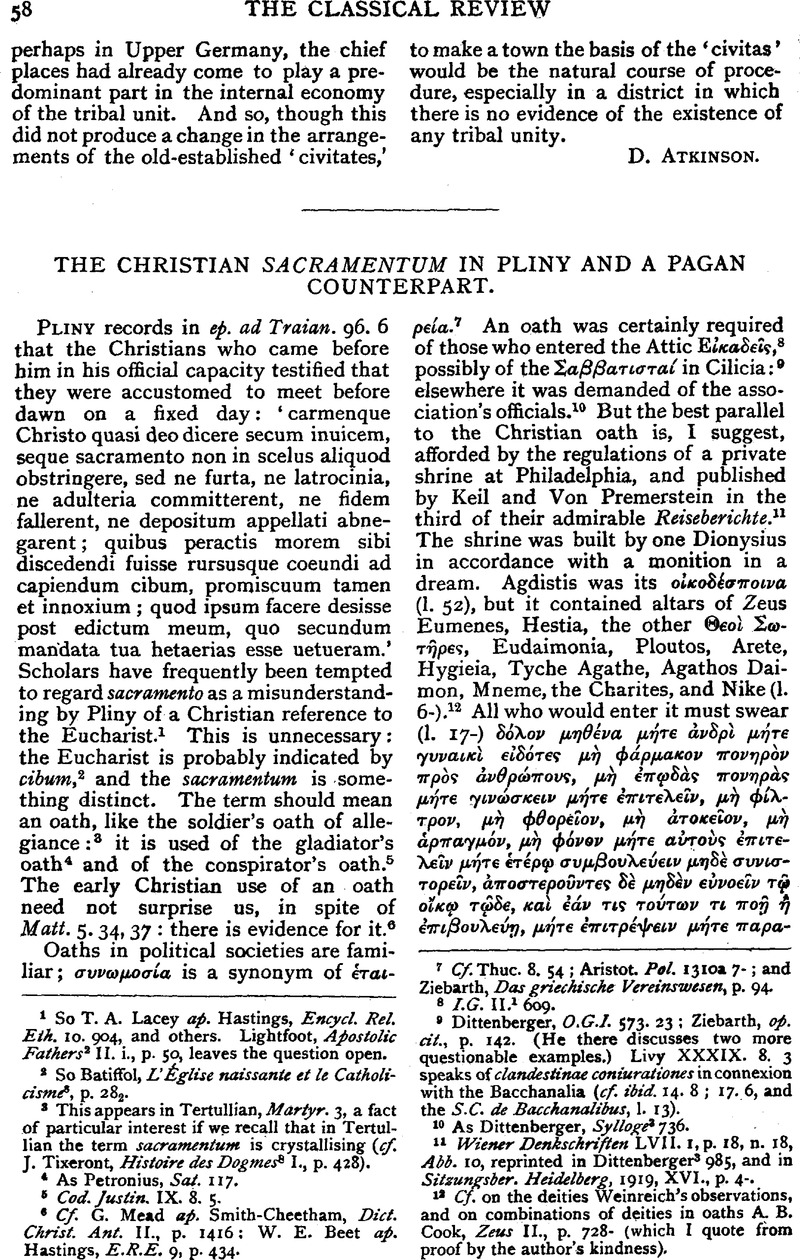No CrossRef data available.
Article contents
The Christian Sacramentum in Pliny and A Pagan Counterpart
Published online by Cambridge University Press: 27 October 2009
Abstract

- Type
- Review Article
- Information
- Copyright
- Copyright © The Classical Association 1924
References
page 58 note 1 So T. A. Lacey ap. Hastings, Encycl. Rel. Eth. 10. 904, and others. Lightfoot, Apostolic Fathers2 II. i., p. 50, leaves the question open.
page 58 note 2 So Batiffol, L' Église naissante et le Catholicisme5, p. 282.
page 58 note 3 This appears in Tertullian, Martyr. 3, a fact of particular interest if we recall that in Tertullian the term sacramentum is crystallising (cf. Tixeront, J., Histoire des Dogmes8 I., p. 428).Google Scholar
page 58 note 4 As Petronius, Sat. 117.
page 58 note 5 Cod. Justin. IX. 8. 5.
page 58 note 6 Cf. G. Mead ap. Smith-Cheetham, , Dict. Christ. Ant. II., p. 1416Google Scholar: W. E. Beet ap. Hastings, E.R.E. 9, p. 434.
page 58 note 7 Cf. Thuc. 8. 54; Aristot. Pol. 1310a 7-; and Ziebarth, Das griechische Vereinswesen, p. 94.
page 58 note 8 I.G. II.1 609.
page 58 note 9 Dittenberger, O.G.I. 573. 23; Ziebarth, op. cit., p. 142. (He there discusses two more questionable examples.) Livy XXXIX- 8. 3 speaks of clandestinae coniurationes in connexion with the Bacchanalia (cf. ibid. 14. 8; 17. 6, and the S.C. de Bacchanalibus, 1. 13).
page 58 note 10 As Dittenberger, Sylloge3 736.
page 58 note 11 Wiener Denkschriften LVII. i, p. 18, n. 18, Abb. 10, reprinted in Dittenberger3 985, and in Sitzungsber. Heidelberg, 1919, XVI., p. 4-.
page 58 note 12 Cf. on the deities Weinreich's observations, and on combinations of deities in oaths Cook, A. B., Zeus II., p. 728Google Scholar- (which I quote from proof by the author's kindness).
page 59 note 1 So the editors rightly infer from παρθενoν (1. 28).
page 59 note 2 ![]() (1. 40). For ρν cf. Hom. H. ad Demet. 480 (Eleusinian) with Allen and Sikes ad loc.
(1. 40). For ρν cf. Hom. H. ad Demet. 480 (Eleusinian) with Allen and Sikes ad loc.
page 59 note 3 His opinion is quoted in Dittenberger.
page 59 note 4 Cf. p. 59 of Weinreich's paper for a detailed comparison.
page 59 note 5 The Philadelphian oath was, of course, to be taken once only. For the Christian use pagan practices cf. the judicious discussions of Delahaye, H., Les Légendes hagiographiques2, p. 168–Google Scholar; and Geffcken, J., Der Ausgang des griechisch-römischen Heidentums, p. 224–.Google Scholar
page 59 note 6 Dittenberger 983. 3-: cf. Porphyry, de abst. II. 17, and Fehrle, E., Religionsgeschichtliche Versuche und Vorarbeiten VI., p. 50.Google Scholar
page 59 note 7 Roussel, , Mélanges Homolle (1913), p. 276, 1. 14.Google Scholar
page 59 note 8 Cf. Lactantius, Diuin. instit. V. 14, ‘nemo apud eum (sc. deum) seruus est, nemo dominus.’ For the older exclusions cf. Wächter, R.G. V. V. IX. i., p. 123- (slaves), p. 118- (foreigners).
page 59 note 9 ap. Stob. flor. 6. 23 (III., p. 286-, Hense); cf. his condemnation of abortion, id. 75. 15 (p. 601, Hense), in marked contrast with Plato, Rep. 461c, Theaet. 149D, Aristot. Pol. 1335b 23, and in accordance with the Hippocratic Oath.
page 59 note 10 Carmina latina epigraphica, ed. Bücheler 254. cuncti was regarded by the ancients as equivalent to coniuncti (Seru. ad Aen. I. 518; cf. Thesaurus 1. L. IV. 1396, 1400). Petronius' parody of the Senecan teaching that slaves are our brothers (Sat. 71: cf. B. W. Henderson, The Principate of Nero, p. 93) bears witness to its dissemination. On the spread of ethical ideas cf. further Deissmann, A., Licht vom Osten4, p. 262–Google Scholar; O. Kern, P. IV. X. 1434. Sarapis and Isis protect all who ![]() , says aDelian inscription of the second century B.C. (Weinreich, , Neue Urkunden zur Sarapisreligion, p. 31, 1. 33).Google Scholar
, says aDelian inscription of the second century B.C. (Weinreich, , Neue Urkunden zur Sarapisreligion, p. 31, 1. 33).Google Scholar


